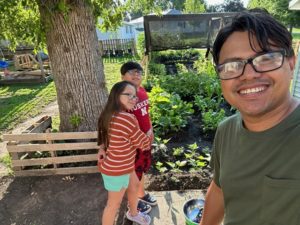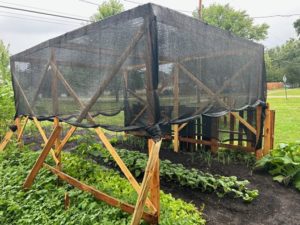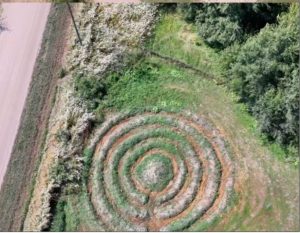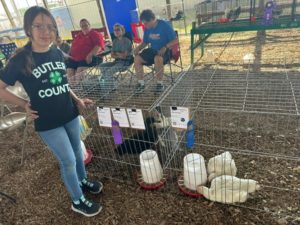“Rooted in Nature and Guided by Tradition”
At NaTerra Farm, Sandro Lopes is applying Indigenous knowledge to grow food and community.
2022 was a pivotal year for Sandro Lopes.
He started a backyard garden at his house in David City, Nebraska, out of a desire to feed his family and his community. At the time, Sandro was working 12-hour days as a contractor at a corn processing plant. The work environment was dusty, hot and left him feeling uninspired.
That same year, his mother, Maria Mont Serrat, came from Brazil to live with Sandro, his wife, Michelle, and their four children. Sandro grew up in Brazil and is descended from the Indigenous Tupí people.
“My ancestors come from Itacoã-Miri, a small community in the city of Acará, in the state of Pará,” he says. “It is a place full of history.”
Portuguese colonization, which started in the 16th century, had a profound impact on Brazil’s Indigenous Peoples. Sandro notes that he’s the fourth generation of the Itacoã-Miri community that does not speak the language (Tupí is part of the Tupí-Guarani language family). “Yet, the memory of our people remains alive,” he says.
Sandro’s mother is such a knowledge-bearer. In Tupí-Guarani, she is known as an ekuñakarai, a word used for a grandmother, spiritual leader, counselor and teacher of traditions for the family. When she moved to Nebraska, Maria started teaching the Lopes family traditional Indigenous ways of growing food in raised beds. She also taught them how to make biochar, a high-carbon form of charcoal made by heating organic matter like plants or wood chips in a low-oxygen environment that can improve soil health. And she introduced them to other Indigenous cultivation practices for sustaining people and nature that she had learned growing up in the rainforest.
By 2023, Sandro had officially started NaTerra Regenerative Farm, where he is blending this ancestral knowledge with permaculture
principles and adapting it to a Midwestern context. His garden now fills nearly his entire backyard – and in 2024, he expanded his farm to a nearby 3-acre plot.
Today, Sandro raises produce for a CSA, along with free-range chickens and eggs. He also has goats, ducks and quail that his 12-year-old daughter, Maria, tends and shows through 4-H. His goal with his farm is to create a unified system – one that forges a harmony between the land, the people and other beings it sustains, along with the Indigenous wisdom that has been passed down to him.
Ancestral Practices
That ancestral knowledge is evident in some of the innovative practices Sandro uses at NaTerra Farm. One practice, called muvuka – which means “together” in Tupí – is based on planting different species together so they can support one another, along with soil health and biodiversity. He also seeks to mimic aspects of tropical rainforest ecosystems.
In practice, because the local climate is markedly different from tropical Brazil, this means creative adaptation. “The Nebraska sun shines differently,” Sandro says. “Keeping the soil, seeds and plants moist is not a problem in the Brazilian soil, seeds and plants moist is not a problem in the Brazilian rainforest. But in Nebraska, dry air can be a challenge.”
To cope, Sandro shades his plants with a custom structure he built. It consists of a wood frame topped with chicken wire. As Sandro weeds, he puts the discarded plants on top of the structure to create a natural tarp of foliage, imitating a live plant shade canopy. When the seeds emerge, he moves the tarp on a rotation. The practice lets him grow a lot of food in a small space.
Another practice uses crop rotation, ground cover and composting to enrich the soil and boost crop productivity. Sandro is serious about building soil health at NaTerra Farm. “In the rainforest, there is no lab to test your soil. Instead, we practice bio-observation,” he says. “We learn by observing the colors. We consider red, purple, lilac, grey and black fungi signs of pathogenic microbial communities in the soil, and white, green and yellow fungi signs of beneficial microbial communities.”
To encourage the beneficial microbes, Sandro explains how some farmers in Brazil “trap” beneficial microorganisms by taking a small ball of rice, putting it in the ground next to the bacteria and covering it with leaves. “The microorganisms jump to the rice,” he says. This Native method, taught to Sandro by farmers hosting field days in Brazil, requires the rice to be left in the ground until the good bacteria multiplies. The rice ball is then transplanted into soil that’s lacking the proper nutrition to grow food.
Sandro uses other creative approaches to building soil health. A nearby landowner, who has given Sandro access to additional land to farm, regularly dredges a lake on the property and piles the silt on the shore. Sandro decided to transplant that soil to the 3-acre farm plot he started on the land, using the fish manure in the lake sediment as a nutrient source. The land is the site of Sandro’s newest endeavor: a mandala farm, which he started in 2024.
The concept – which uses a circular design – blends Indigenous agriculture and permaculture practices. Currently, the mandala plot has three concentric rings comprising around 2,900 square feet. Different types of plants grow in each circle. In Sandro’s mandala, the innermost circle is dedicated to short-cycle vegetables, medicinal plants and small flowers that attract beneficial insects. In the second circle, he plants vegetables that need a little more time to mature, as well as corn, beans and squash.
“And the third [outermost] circle is the ecological backbone of the mandala,” Sandro says. “This circle contains fruit trees, shrubs, windbreaks and plants that provide biomass and habitat for wildlife. It is a space dedicated to soil regeneration and ecosystem services.” The mandala farm will eventually grow into a forest. “That is the purpose,” he says. “We establish a forest in the mandala, then plant more mandalas to grow more food and forests.”
Connections to Past, Present and Future
Sandro developed the mandala farm as part of a conservation fellowship program for beginning farmers through Center for Rural Affairs, which offers participants support, funding and mentorship. That genesis – and the fact that the project grew out of engagement with others – pleases Sandro. “One of the purposes of the mandalas is to farm together,” he says. “You need multiple people for it to work.”
Interconnection is a key attribute. The mandala embodies connections between soil, plants, people and other living beings. But it also reflects the layers of knowledge and relationships that have connected him to his heritage, his community – and his family.
Sandro’s daughter, Maria, for instance, will graze her chickens at the mandala to help build soil health. She is especially interested in learning Native growing methods from her grandmother, he says. Sandro uses the Tupí word mborayvu to describe his mother’s relationship with Maria. “It means knowledge- and tradition-sharing from one human to the next, not out of obligation, but out of generosity.” Sandro adds that his son Gui, Maria’s twin, has autism and walking the concentric circles relaxes him. “I love being at the mandala with Gui. It is something we can enjoy together.”
The concept of interconnection is also vividly illustrated in NaTerra Farm’s logo. It depicts the Lopes family’s 140-year-old house nestled within the trunk of a tree. At the tree’s center is Ceuci, the Tupí goddess of agriculture. Living soil is shown as red lines flowing underneath. “NaTerra Farm is rooted in nature and guided by tradition,” Sandro says. “We believe, in order to start a farm, you need Ceuci and she needs to be guided by the spirit of the tree.”
For Sandro, people and land are connected across space and time. As he builds his farm, he’s doing so with future generations in mind as well. “The top of one mountain is the bottom of the next,” Sandro says. He follows that up by reminding us to “keep climbing.”




